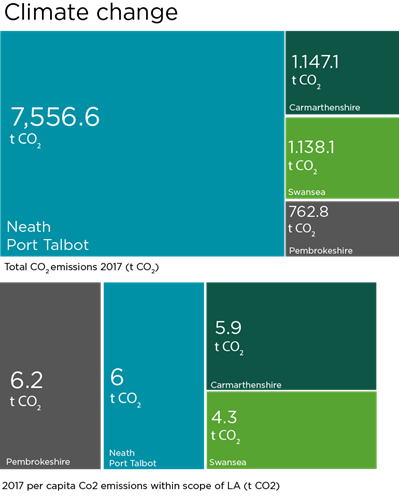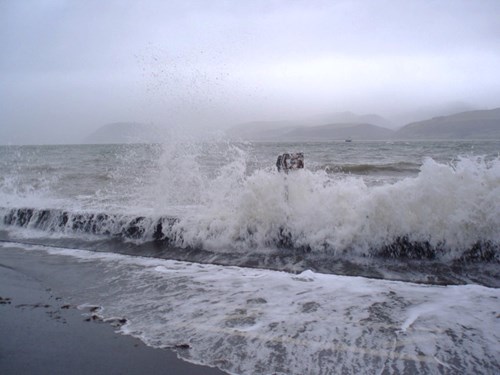Introduction to South West Area Statement
Welcome to the South West Wales Area Statement....

Climate change is one of, if not THE, defining issues of our time. From shifting weather patterns that threaten our food production to rising sea levels and the prospect of catastrophic flooding, the impacts of climate change are far reaching and is being experienced at a global scale. Drastic action needs to be taken right now – to reduce the causes and negative impacts of climate change, as well as adapting to the changes that will occur.
Delaying action will not only make the task more difficult and costly, but also potentially be too late.
Rising to the challenge requires concerted action at a global, international and local level. The Welsh Government’s response was to declare a climate emergency in 2019, stating:
“No nation in the world has yet fully grasped this challenge but just as Wales played a leading role in the first industrial revolution, I believe Wales can provide an example to others of what it means to achieve environmental growth” (Mark Drakeford, First Minister)
Wales has also committed to become carbon neutral in its public sector by 2030 and the policies within the plan ‘Prosperity for All: A Low Carbon Wales’ help to address the problem.
This Area Statement considers the contributions and changes that we need make as individuals, communities and organisations in South West Wales.
It is clear that climate change is a cross-cutting issue as it has much in common with the other themes of this Area Statement:
In responding to this theme, we need to recognise these links and aim to deliver multiple benefits that help address climate change. For instance, increasing woodland cover next to a community not only enhances biodiversity, social health and well-being, but also enables trees to act as ‘carbon sinks’, soaking up excess water and reducing what’s known as the ‘urban heat island effect’, something that occurs when an urban area becomes significantly warmer than surrounding areas due to human activity. Amazing as it sounds, but an 80-foot beech tree has been shown to absorb the daily carbon dioxide output of two family homes.
Some of the other key considerations in tackling this issue are:
The coastal zone connects the land and marine environment. There is therefore a need to consider the Marine Area Statement theme nature-based solutions and adaptation at the coast in conjunction with the actions set out here; the Marine Area Statement identifies coastal zone management and adaptation as areas that deliver the most opportunities in terms of both building ecosystem resilience and benefits across the well-being goals (in terms of tackling climate change).
While global emissions (CO2 equivalent) have risen steadily over the last few decades, Welsh emissions have shown some decline between 1990 and 2016. Within Wales by far the biggest emitting sector is business and industry. Below are the top four carbon emitting sectors in Wales:
Within South West Wales over the period 2005 – 2015 the domestic and industrial sectors reduced their emissions by ~30%; transport emissions during this period have only decreased 5.2%. Additionally, overall emissions between 2015 and 2016 have increased by 5%, primarily driven by an increase in power generation emissions.

Due to its geographical position, the UK has one of the most variable climates in the world. Winds reaching us from the Atlantic, southern Europe, continental Europe and the polar region bring quite different weather with them. Our weather is, therefore, relatively unpredictable from day to day. The effects of global climate change will make these patterns more extreme.
In Wales we can expect to see more intense rainfall, more flooding in some areas as well as hotter, drier summers. The projections also foresee more extremely warm days, milder and wetter winters, less snowfall and frost as well as lower groundwater levels.
Summary of projections:
For more information see UKCP18 Land projection map
Every five years the UK Government undertakes a UK Climate Change Risk Assessment. The second report was published in 2017 and considered the following question:
“Based on the latest understanding of current, and future, climate risks/opportunities, vulnerability and adaptation, what should the priorities be for the next UK National Adaptation Programme and adaptation programmes of the devolved (Wales, Scotland and Northern Ireland) administrations?”
The top six areas of climate change risk for the UK are set out below:-
All of these, to a greater or lesser extent, apply to South West Wales.
The Welsh Government is currently updating its Climate Change Adaptation Delivery Plan in the light of these findings. These risks and the Welsh Government’s planned actions will need to be viewed alongside the Area Statement and addressed as an integral part of partners’ work programmes. Visit the Committee on Climate Change website.

A key part of the development of this Area Statement has been our engagement with stakeholders and we say more about this in the next section.
In the other Themes, we set out ‘what success looks like’ as a series of you told us statements reflecting the general consensus from our engagement sessions. Perhaps because of the uncertainties we face, our discussions around the climate emergency were less defined in terms of action and we need to have further discussion around this topic. Please see the section at the end of this theme which details how you can remain part of this process.
Nevertheless, it was made clear to us that climate change needs to have a greater prominence in the Area Statement with a clear acknowledgement of the ongoing climate emergency. You also told us that:

In developing this Area Statement our aim has been to work collaboratively and represent the views and ideas from all stakeholders in South West Wales. Our goal has been to involve you in helping identify the key risks that we all face in managing our natural resources sustainably, as well as the opportunities.
This has required a different way of working.
We have undertaken a wide range of engagement activities, including targeted planning workshops with selected experts to larger workshops involving many sectors. The latter have been well attended and included publicly elected representatives, community groups, environmental Non Government Organisations, as well as officials from the public sector. We’ve also ensured that representative groups (such as farming unions, angling associations etc) have been included. The business sector has mainly been represented by larger industry.
As many different sectors have been included as possible to capture the widest range of views and expertise.
Internally we have been working closely with our colleagues developing the South Central Wales, Marine and Mid Wales Area Statements to ensure that actions link up where appropriate. In particular, the coastal zone and marine environment are very important for us in South West Wales and we recognise that what happens on land often impacts the sea and vice versa.
We need your continued support to progress the opportunities and actions we set out earlier and in this section. We will be continuing our conversations with you on how best to take this forward – both in terms of delivery and in refining the detail where further work is needed. This is likely to involve more focused work on specific themes or around particular geographical areas (e.g. the opportunity catchments).
So, we encourage all stakeholders, existing and new, to get involved.
Whilst further conversations are needed, there are clear opportunities for action now. These include changing our behaviours, mitigation, adaption, and implementing the priority actions identified to support the Welsh Government’s declaration of a Climate and Nature Emergency. Areas we will pursue are as follows:
planting new woodland where appropriate
(Linking with our Sustainable Land Management Theme and Marine Area Statement)
(Linking with our Sustainable Land Management Theme)
(Linking with the Reducing health inequality and Biodiversity Theme)
We have sought to embody the principles behind the Sustainable Management of Natural Resources (SMNR) in our South West Area Statement. At the heart of its development has been our collaborative engagement with a broad range of partners and stakeholders, both existing and new. Whereas we would have traditionally developed a plan and then consulted on it, we have involved others throughout. We have drawn upon our collective evidence and knowledge to identify the key issues that we face in South West Wales and these have framed the four themes and our vision of success. We have begun to explore the opportunities and actions where we can work better together, to achieve long lasting and integrated benefits. Our challenge now is to work together with partners, stakeholders and communities in turning these ideas and words into action. We don’t have the answer to everything, but we will learn and adapt as we go.
This theme is only the beginning of the journey as we work with people to improve the management of South West Wales. If you would like to be part of this process, please get in touch with us using the form below. Alternatively, please email us direct at: Southwest.as@cyfoethnaturiolcymru.gov.uk